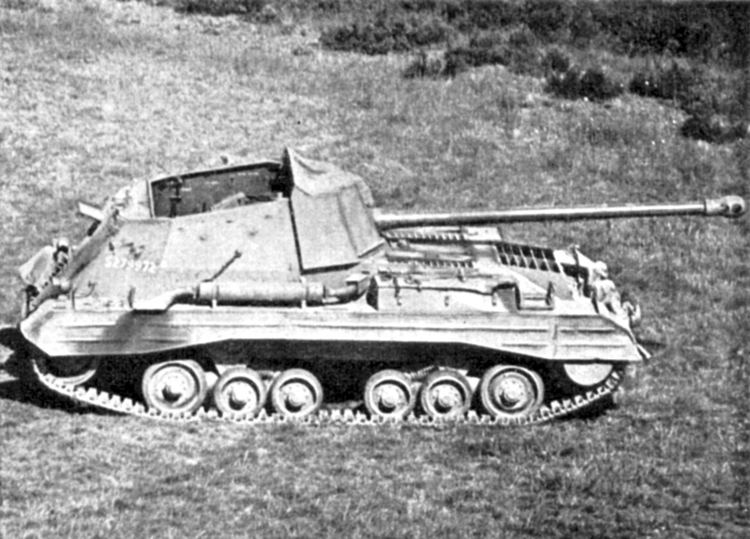Place of origin United Kingdom | Used by United Kingdom, Egypt | |
 | ||
In service September 1944 - ? (UK) Wars World War II, Suez Crisis | ||
The Self Propelled 17pdr, Valentine, Mk I, Archer was a British self propelled anti-tank gun of the Second World War based on the Valentine infantry tank chassis fitted with an Ordnance QF 17 pounder gun. Designed and manufactured by Vickers-Armstrongs, 655 were produced between March 1943 - May 1945. It was used in North-West Europe and Italy during the war and post-war the Archer served with the Egyptian Army. The vehicle was unique for its gun being mounted facing the rear of the chassis instead of the front.
Contents
Design and development
The 17 pounder anti-tank gun was very powerful but also very large and heavy, and could be moved about the battlefield only by a vehicle, which made the gun more effective in defence than in the attack. An extemporized modification of the Churchill tank had been tested in 1942 as a self-propelled gun; the "3-inch Gun Carrier" and the US was expected to be able to provide the 76-mm armed M10 tank destroyer through Lend-lease. Other projects were considered using obsolete tank chassis, including the Valentine for its reliability and low profile, and the Crusader for its good power-to-weight ratio. In development were tank designs using the 17-pounder, which led to the Cruiser Mk VIII Challenger tank (and its post-war variant the Avenger SP gun) derived from the Cromwell cruiser tank and the Sherman Firefly conversion of the Sherman tank.
The Valentine chassis was soon chosen, as it was in production but obsolescent for British use and was also one of the few chassis that could accommodate such a large gun. The engine in the Archer had a higher power rating than in the Valentine. Since the Valentine had a small hull and it was not possible to use a turret, the gun was mounted in a simple, low, open-topped armoured box, very much like the early Panzerjäger German self-propelled guns in appearance, with the gun facing to the rear, which kept the length of the Archer short. The mounting allowed for 11 degrees of traverse to either side, with elevation from -7.5 to +15 degrees.
On firing, the gun breech recoiled into the driver's space, with the driver staying in position, in case the vehicle needed to move quickly. The rear mounting combined with its low silhouette made the Archer an excellent ambush weapon, allowing its crew to fire, then drive away without turning round. The first prototype was completed in 1943, with firing trials carried out in April 1943. Vickers were given orders for 800 vehicles.
Service
Production started in mid-1943 and the Archer entered service in October 1944. It was used in North-West Europe and (in 1945) in Italy. By the end of the war, 655 of them had been produced. The Archer was classified as a self-propelled anti-tank gun and was operated during the war by the Royal Artillery (RA) rather than by Royal Armoured Corps units, as were the British 3in SPG M10 and 17pdr SP Achilles.
These vehicles were never classified as "tank destroyers" as the British and Commonwealth armies never used the tank destroyer doctrine. They were classified and used as "self-propelled anti-tank guns".
Post-war, the Archer served with the Egyptian Army. The Archer served with some units of the Royal Armoured Corps in the British Army of the Rhine (BAOR) in the early 1950s.
Surviving vehicles
Surviving vehicles are preserved at the Yad La-Shiryon museum in Latrun, National War and Resistance Museum, Overloon in the Netherlands and the The Tank Museum in the UK. There is one Archer with a short-barreled gun minus gun mantlet at the Cavalry Tank Museum, Ahmednagar, India.
